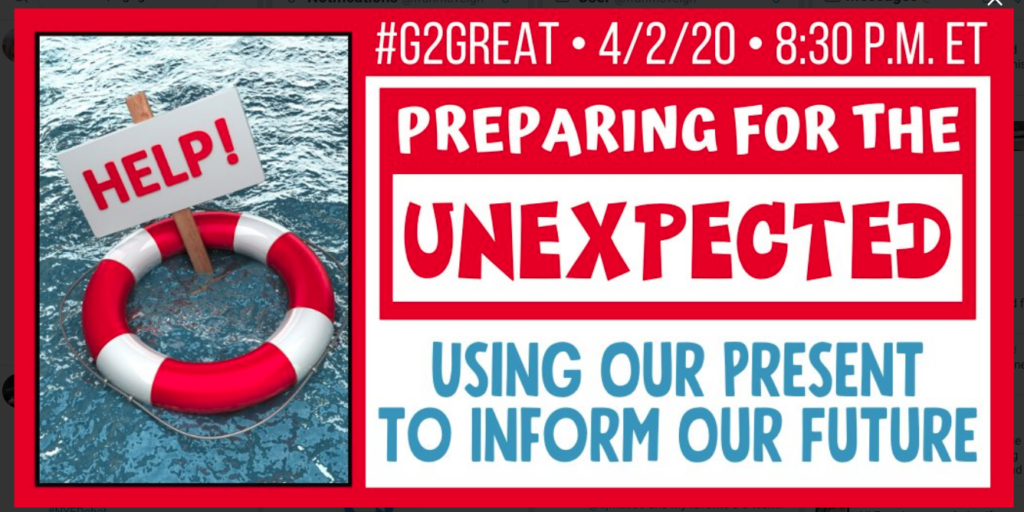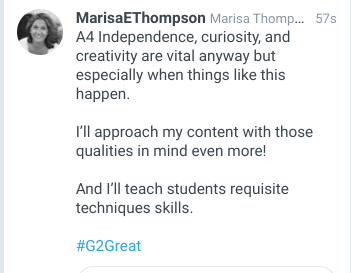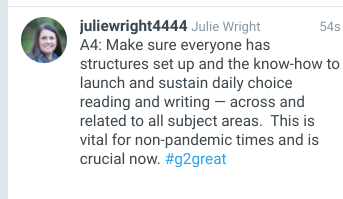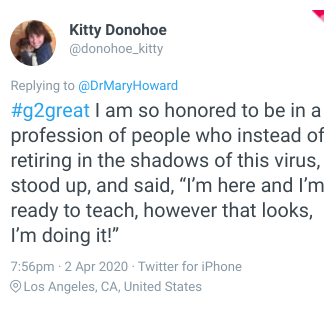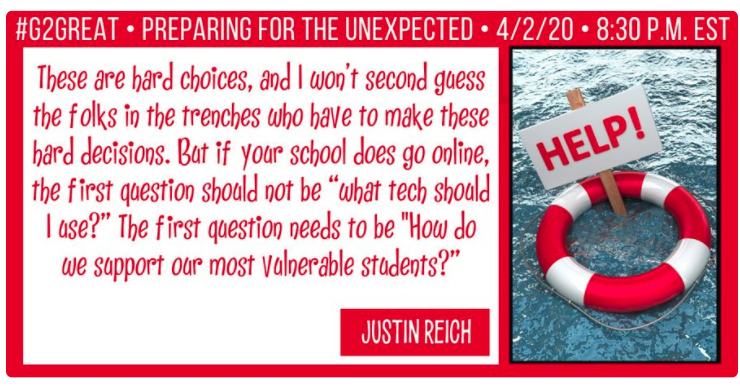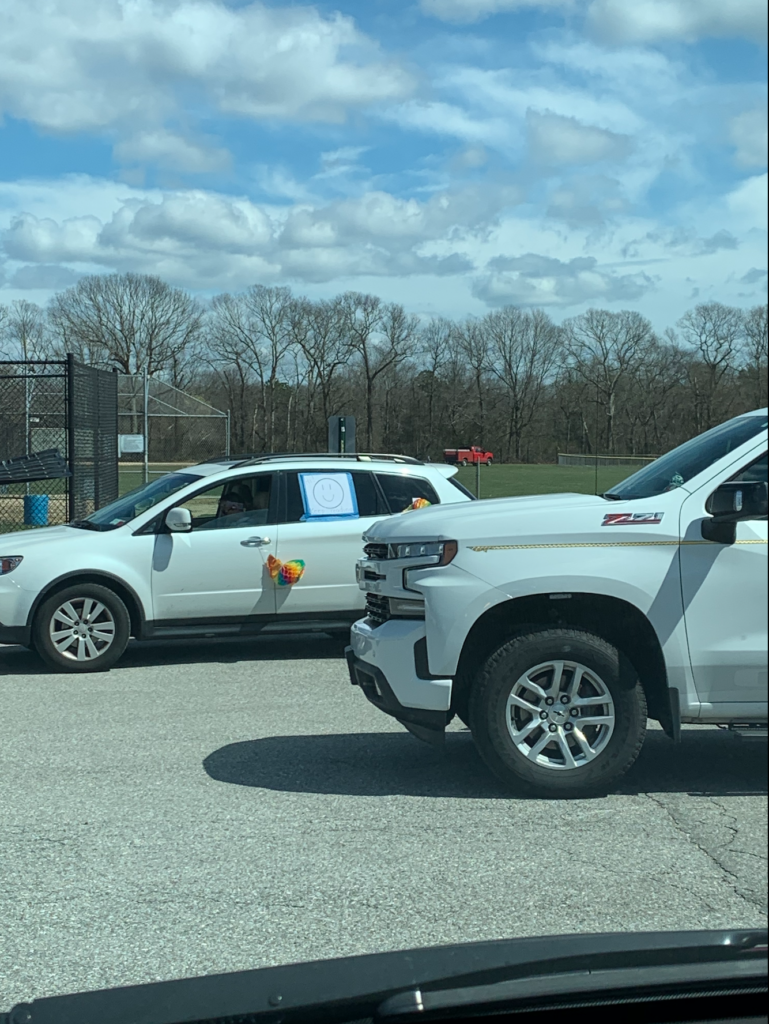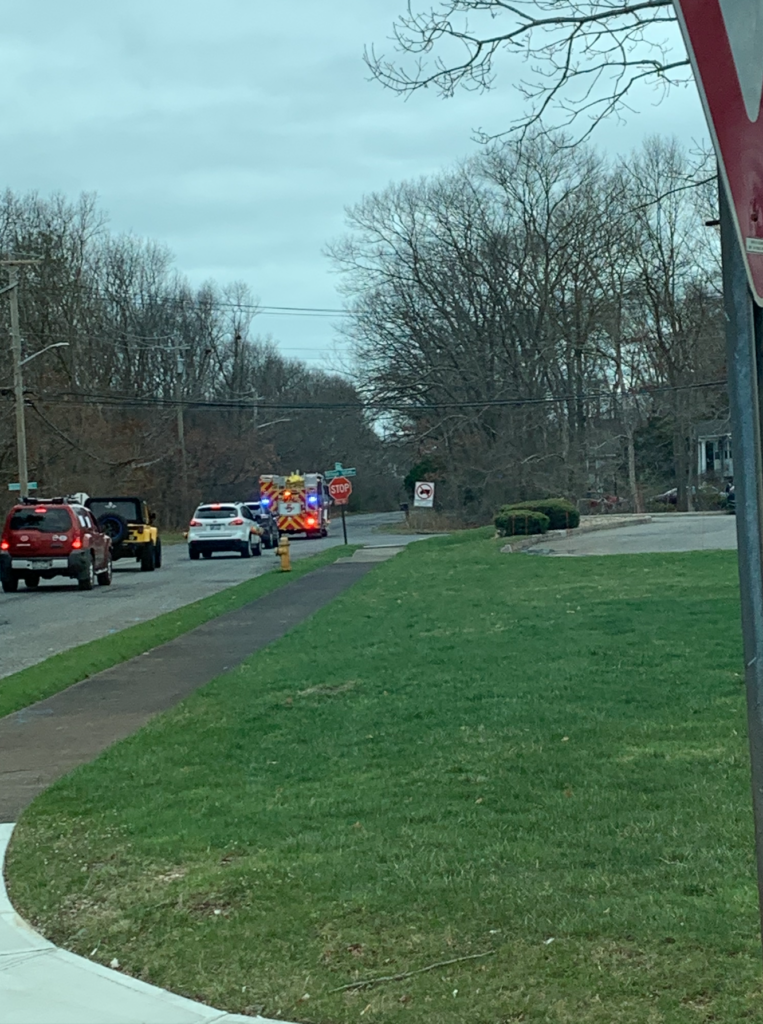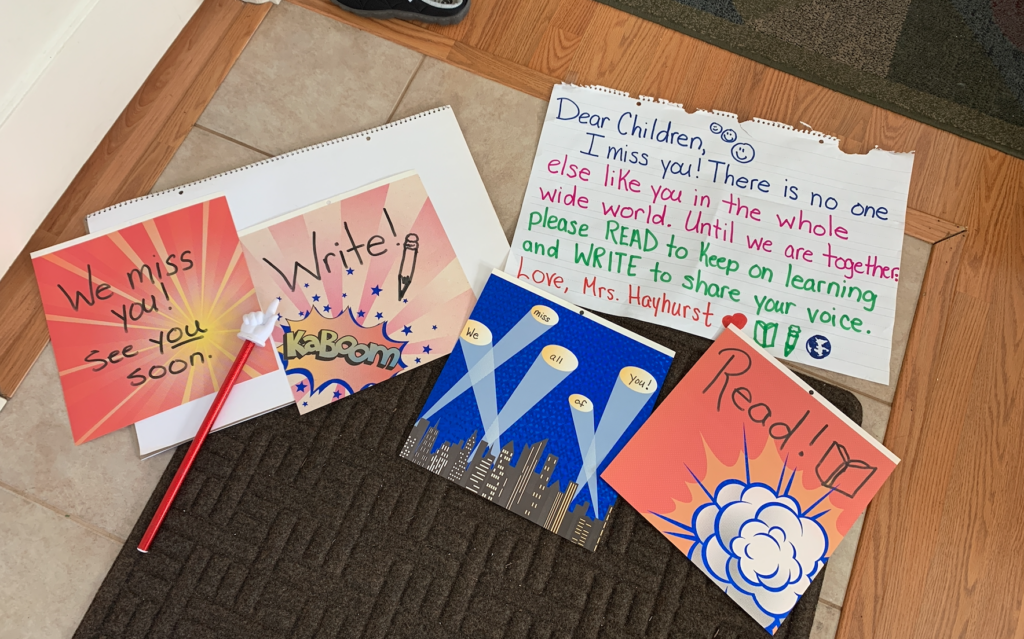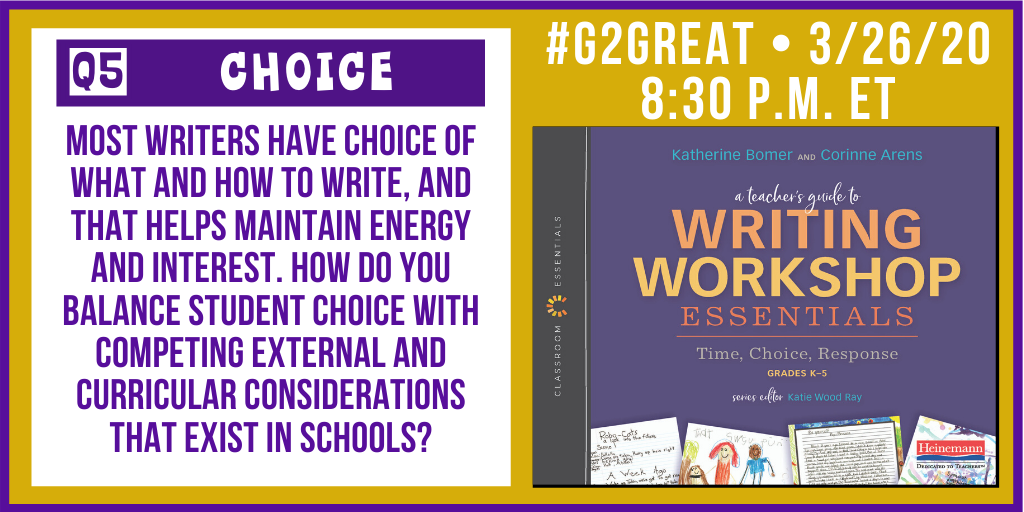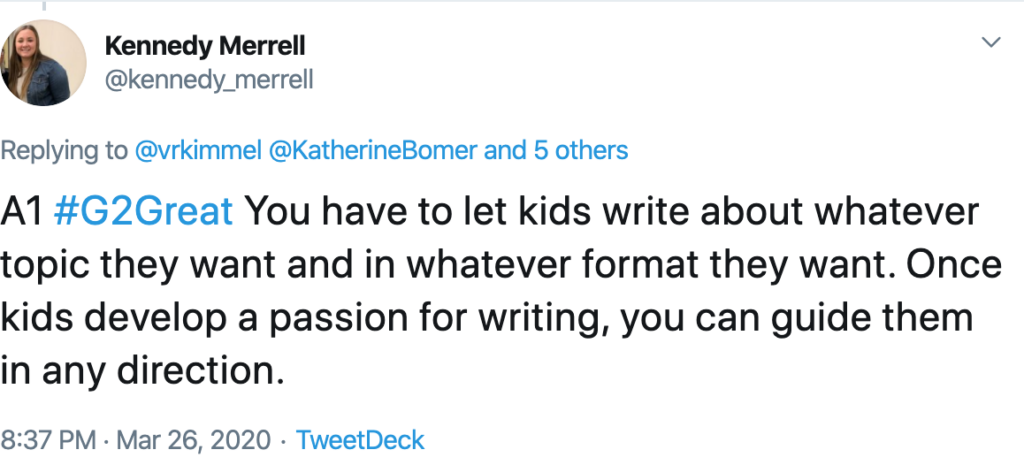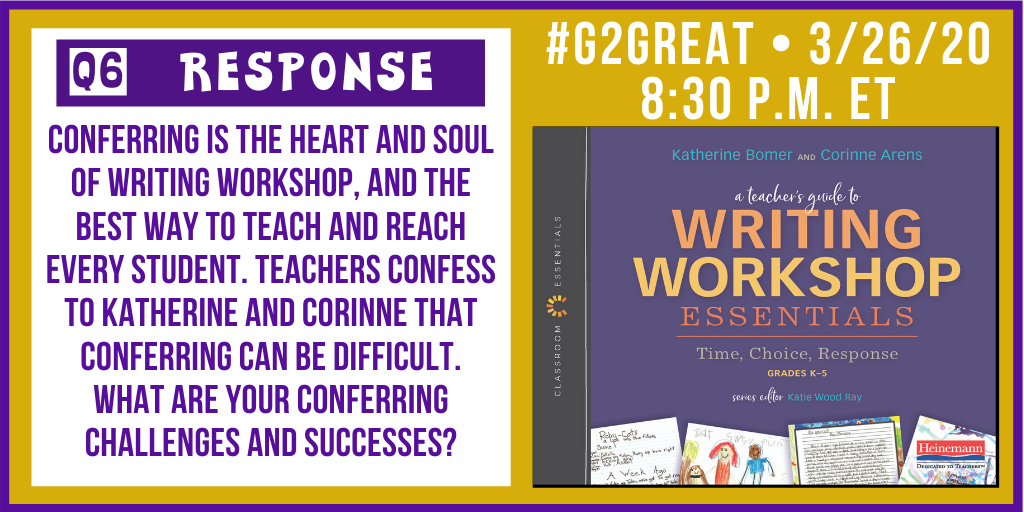Guest blog post by Laura Robb and Evan Robb

On 4/23/20, #G2Great invited our chat family to discuss a critical topic, Breaking the Cycle of Professional Compliance: Teachers as Decision-Makers. We are so grateful that our friends Laura Robb and Evan Robb shared their wisdom with us all in this wonderful post.
Gracie Jordan has been teaching ELA to sixth graders in a small southern town for five years. A fan of workshop, Gracie has 90-minutes a day to teach reading and writing. Every day she reads aloud to students. Her classroom library has 800 books and her students read self-selected books independently for 15 to 20 minutes a day. For instruction, Gracie organizes literature circles, and students select books to read in small groups—books of the same genre that meet their instructional needs. Step into Gracie’s classroom and you’ll notice displays of books on windowsills, bookshelves, and underneath the chalkboard. And if you observe a few classes, you would see students creating book displays, negotiating deadlines for completing books, and collaborating to write and perform readers’ theater.
Used to making instructional decisions for the benefit of all her students, Gracie confers frequently with each one. Mr. Roberts, the principal, funds annual additions to Gracie’s and other workshop teachers’ collection of books for literature circles as well as their classroom libraries.
Gracie’s World Turns Upside-Down
In early June, Gracie and other ELA teachers at her school receive a letter from the new superintendent explaining that the central office with the school board’s approval has adopted a basal reading program for K to 8 students. ELA teachers are to become familiar with the program’s many components over summer break, attend a workshop in August about the new program, and teach it with fidelity during the upcoming school year. Indeed, moving from reading workshop and using wonderful books to a basal reading program had turned Gracie’s teaching world along with several of her colleagues topsey-turvey! Two questions continually bombard Gracie’s mind: How will I make time for my students to read books they select? Will I be able to follow this change in instruction with total fidelity?
What’s Wrong With This Snapshot?
A chief administrator of a school district, the superintendent’s decisions can reveal whether teachers and administrators will be valued as thinkers and decision-makers or as staff who comply and follow top-down decisions. Often, a new superintendent arrives in the district and implements curricular changes that worked in his/her former school district. The letter to teachers did not explain the rationale for the decision. The problem Gracie and others have is the superintendent imposed a basal reading program on K to 8 teachers and administrators without collaborative discussions, without citing evidence from their test scores for such a dramatic change, and without a knowledge of whether the teaching and learning in their classrooms supports all students.
Actually, the new superintendent’s decision reveals a lack of consensus building and appears to be based on a belief that if this reading program worked in his former district, it would work in all districts. However, all districts don’t necessarily benefit from one method of instruction, nor do they have student populations with the same needs. By not canvassing principals and other school leaders to gain insights into students’ reading achievement and determine whether a workshop model and schools filled with books support students’ growth and progress, frustration levels rise. The consensus among teachers is that the new superintendent wants compliance.
To Comply or Not to Comply
Gracie and other teachers in her building face a major dilemma: Should they acquiesce to a one-size-fits-all reading program, when they know that all students in their middle school aren’t reading on grade level. However, a review of annual tests over the past five years indicates that students are making progress and developing reading proficiency. Mr. Roberts, Gracie’s principal, views his teachers as informed decision-makers. He encourages formative assessment as a way to continually evaluate students’ progress and develop targeted interventions and instruction that consider the needs of every reader.
Moving to a basal program where the “experts” make all the decisions for students they don’t know seems unreasonable to Gracie. Now, she and others will be required to deliver lessons they didn’t develop and move forward with the program, even if several students require specific support in order to succeed with the next wave of lessons. Gracie’s heart is heavy with worry for her students, and her mind raises questions again and again: How will I find time for students to read? When will I be able to support students who need extra help? When will I confer with students? What will happen to students who can’t read the program’s stories?
Gracie is unable to envision herself as anything but a responsible and responsive decision-maker when it comes to her students’ reading instruction. After reflecting on herself as a teacher and her desire to continue to support each student, she makes a good decision: Gracie sets up a meeting with Mr. Roberts, her principal. He supports the workshop model, reads aloud to classes, and always shares his enthusiasm for the volume in reading students are doing. Maybe, Gracie thought, she could work out a compromise with him.
Gracie’s Meeting With Mr. Roberts
Mr. Roberts respects Gracie and her colleagues’ ability to use formative assessments in their reading workshop in order to be responsive to students’ learning and progress. He listens carefully to Gracie’s discussion points, nodding in agreement when she points out that students’ progress is steady in her classes and in other classes using reading workshop. She also thanks Mr. Roberts for the annual funds he releases to enlarge classroom libraries and books for instruction.
Mr. Roberts explains that he and other principals are also struggling with the superintendent’s decision to purchase a basal reading program, as they weren’t consulted. In a recent meeting with the superintendent, the district’s principals did negotiate some flexibility. Teachers could start their ELA classes with 15-20 minutes of students reading self-selected books and then implement the basal.
“What about my students who can’t read the grade level stories in the basal? If I read them out loud, the students aren’t doing the reading. And the directions on the worksheets will pose challenges to this group.”
“Find alternate books and stories on the same genre for students who can’t read and comprehend grade-level materials.” Mr. Roberts understands the value of volume in reading. He also believes that his responsibility is to the students in his building and helping teachers enlarge their reading skill and expertise.
“Keep in touch with me,” he tells Gracie. ”Especially if you need specific books to meet every student’s needs.” Your advanced readers will need more of a challenge than stories in a grade-level basal.”
Gracie left feeling more positive, especially because Mr. Roberts supports her and knows the research on reading. Her only worry is that Mr. Roberts could be reprimanded for allowing accommodations to the basal program.
A New Superintendent’s Role
When a superintendent arrives in his or her new school district, it’s important that he/she learn a great deal about the culture of each school as well as students’ strengths and needs. To accomplish this, it’s crucial that the superintendent meet with principals and other school leaders, groups of teachers, and parents, to understand how the district’s community sees teaching and learning. In addition, before making sweeping change in an academic discipline, it would seem logical that besides discussions with school stakeholders, the superintendent would gather testing data over the past five to ten years to understand the story the data reveals.
Evan, a middle school principal, and I believe that a top down decision calling for compliance from school administrators and teachers will foster anxiety and frustration among staff that believe in consensus building. Ultimately, the decision to substitute reading workshop where teachers make informed decisions could result in losing teachers who feel stifled and unappreciated as well as thoughtful principals, such as Mr. Roberts, who believe in teacher agency and empowerment.
The Principal’s Role in a Compliant Environment
For Evan, a principal’s major responsibility is to his school and its staff, students, and families. So what can a principal do when he or she is also the recipient of a top down decision from a superintendent? It’s time for courageous conversations with the superintendent, even though the principal is risking negative reactions. It’s also time to listen to teachers, empathize with their concerns, and find ways to compromise for students’ benefit. Here are seven suggestions for principals caught in a situation requiring compliance:
- Listen carefully to teachers that request meetings, empathize with their feelings, and follow-up once you have more information.
- Have a conversation with the new superintendent even though this could be risky. Bring long-term data to review as well as explain what teachers are presently doing in ELA and content classes.
- Invite the superintendent to visit schools and spend time in classrooms to understand instructional methods as well as build relationships with teachers.
- Discuss compromises and ways teachers can have flexibility with implementing the basal program.
- Work with other principals to build a trusting relationship with the superintendent so decision-making moves from compliant and top-down to shared decision making that takes into account the culture and population of each school in a district.
- Communicate with teachers to acknowledge respect for their knowledge, ability to use formative assessments to inform instruction and interventions, and support them as much as possible.
- Find ways to retain outstanding teachers and work to move from compliance back to teacher agency–teachers as informed decision-makers.
Building Teacher Agency & Leadership
Instead of a culture of compliance, Evan and I want to see school districts develop teacher agency and leadership. This can happen when trusting relationships between school leaders and the superintendent develop as well as positive relationships between the superintendent and teachers. We believe that the principal can develop teacher agency and leadership by:
- Collaborating with teachers to explore ongoing building-level professional learning opportunities.
- Showing the importance and value of ongoing professional learning by attending and participating in these school-based opportunities.
- Encouraging staff to join Twitter and Facebook and enlarge their knowledge of teaching and learning through by cultivating a broad Personal Learning Network (PLN).
- Creating time for teams and departments to have conversations about students, teaching practices, interventions, and offer supportive feedback.
- Encouraging teachers to suggest and plan book and article studies to increase their theory of learning and ultimately have the background knowledge to make informed teaching decisions
- Making it possible for teachers to observe colleagues in their building, but also to be able to spend time observing and learning from teachers in other schools.
- Inviting teachers to make national, educational connections and choose a teacher to Skype with and build their educational knowledge base.
- Hosting, as principal, conversations with groups of teachers, to share information, brainstorm ideas to improve curriculum and professional learning, and show your trust in their teaching and learning abilities.
Closing Thoughts
When school leaders require that teachers use a one-size-fits-all program, they discourage teacher agency and ongoing professional learning. Such compliance assumes that all students in a class are at the same instructional reading levels. Instead of being thoughtful and meeting the diverse needs of students sitting in a class, compliance asks teachers to accept the authors of a program as “the authorities” when none of them know their students. This. Doesn’t. Make. Sense.
The Gracie described at the beginning of our blog is the kind of teacher who can best serve the needs of a wide range of students, and Mr. Roberts is an informed and knowledgeable principal who respects, trusts, and values his teachers.
When school leaders encourage teacher agency and ongoing professional learning, it’s possible to break the cycle of professional compliance. Instead of asking teachers to comply, empower them. Instead of a script, trust skilled teachers’ knowledge. Instead of becoming an implementer, help teachers become thoughtful decision-makers. When school districts foster collaboration and communication between administrators and staff, they can work together to create a school culture that empowers members to continually learn and grow in order to meet the needs of every student.
A special thank you to Laura and Evan for this beautiful reflection on such an important topic in education.


